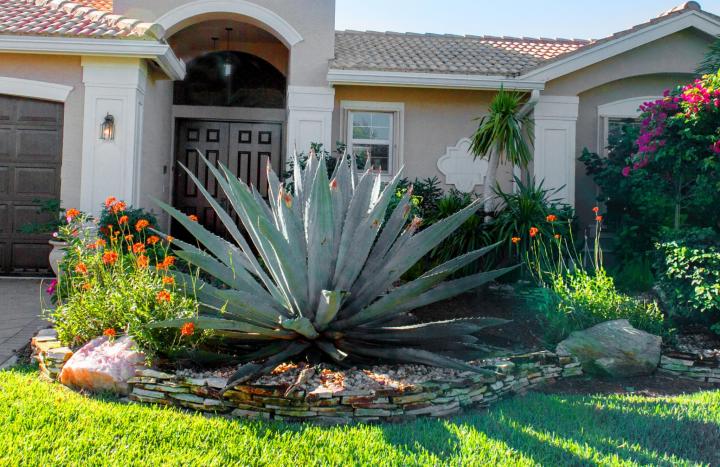Succulents thrive in every North American temperature zone, adding high drama with low maintenance. From stately blue agaves to vivid orange ‘Sticks on Fire’ (Euphorbia tirucalli) or cold-hardy magenta blankets of ice plant (Delosperma cooperi), discover the many colors of succulents.
Succulents have become the decorator plant used to punch up borders, cover problem spots, and add drama to outdoor entertaining areas. Architectural in stature, succulents deliver drama and definition to every bed, border, or container garden.
Succulents’ moisture storage capacity makes them perfect for Xeriscapes (water-conserving plots) and drought-proof, low-maintenance gardens. Their wide variety of shapes, colors, and textures also makes them valuable landscaping plants.
Ideas for Impact
Succulents come in all colors, from yellow-leaf Crassula ovata ‘Hummel’s Sunset’ to magenta-black Aeonium ‘Zwartkop’. Debra Lee Baldwin, author of Designing With Succulents (Timber Press, 2007), says that some of her color favorites are red and teal Kalanchoe luciae and rose, blue, and yellow C. perforata, which “looks like dime-size stacked boxes.”
No matter what color combinations you use, Baldwin advises repetition: “As tempting as it is to have one of everything, repetition creates a better-looking, more cohesive landscape.” Use equal amounts of two or three colors when combining them for balance.
For maximum impact, try complementary color combinations or those across from each other on the color wheel, such as red and lime green or purple and orange.
Consider scale when planting succulents in borders, on slopes, and in rock gardens. Their height should relate to the near structures and to one another. Use small succulents in tiny and enclosed areas.
Reserve larger specimens—yucca, agave, and aloes—for the backs of beds or borders or along tall fences. Ground covers show their beauty best where they can be seen easily on slopes, among rocks, and between stepping-stones.
Repeat shapes, too. You don’t have to use the same plant over and over. Instead, group those with similar silhouettes. Yuccas and agaves have the same spiky shape, for instance. So do rosette-forming succulents such as Echeveria, Sempervivum, and Graptoveria.

Photo credit: Jodi Jacobson/Getty Images
Ground Rules
- If you live in USDA Zone 8 or above, you can grow all succulents outdoors.
- Plant succulents in full sun. Most require at least 6 hours of direct sunlight daily. In hot climates, partial afternoon shade is ideal for retaining color and vigor.
- Provide well-draining soil. Incorporate sand, gravel, and organic matter if your soil is heavy.
- Forget the fertilizer. Succulents thrive in low-fertility ground.
- Keep away from chemicals: lawn fertilizers, pesticides, and herbicides.
- Protect from snails and slugs. If you spot damage, use slug control products such as iron phosphate granules or try barriers such as crushed eggshells, diatomaceous earth, or copper tape (this shocks the pests). Or, try traps such as shallow bowls of beer or overturned pots: Slugs imbibe the beer, fall into it, and drown or crawl underneath overturned pots and can’t escape. Either way, though, you have to dispose of them.
Choices for Chilly Places
Most succulents thrive in narrow temperature ranges occurring between 40° and 90°F, but there are plenty that tolerate freezes and temperatures down into the high 20s—and below. Some thrive in frigid climates where winters dip into the –20s. Normally, freezing temperatures cause plant cells to burst as the water within them expands. Those that are frost tolerant have salts in their cells that lower the freezing point at which damage or death occurs.
The most cold-hardy succulents lose all of their aboveground vegetation and regenerate from roots the following season.
In areas where winter temperatures dip to below 40°F, bring succulents indoors for the winter. Pot plants in a soil-free mixture and keep them in an area that receives at least 4 hours of direct sunlight daily. Water and feed them sparingly and maintain good air circulation.
See top succulents for the home.
